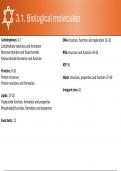Carbohydrates: 2-7 DNA structure, function and replication 22-33
Carbohydrate reactions and formation
Monosaccharides and Disaccharides RNA structure and function 34-35
Polysaccharide formation and function
ATP 36
Proteins: 8-16
Protein structure Water structure, properties and function 37-40
Protein reactions and formation
Inorganic ions 41
Lipids: 17-20
Triglyceride function, formation and properties
Phospholipid function, formation and properties
Food tests: 21
, Carbohydrates:
Carbohydrates
• Carbohydrate reactions and formation
• Monosaccharides
•Carbohydrates
Disaccharides are organic molecules that always contain Carbon, Hydrogen and Oxygen.
•ThePolysaccharides
bonds that from between carbohydrate monomers, or between carbohydrates and other molecules are covale
glycosidic bonds.
Proteins
Carbohydrate Polymerisation: Carbohydrate Hydrolysis
•Carbohydrate
Protein structure
polymers form when a water molecule is removed across the Carbohydrate polymers break back down into their constitue
• Protein
hydroxyl (-OH)reactions and
groups of two formation
carbohydrate molecules monosaccharides when a water molecule is added over the
e.g. Maltose formation connecting the, allowing the hydroxyl groups to reform.
α-glucose + α-glucose → maltose + water
Lipids e.g. Maltose formation
maltose + water → α-glucose + α-glucose
• Triglycerides
-Function, formation, properties
• Phospholipids +
-Function, formation, properties
,Carbohydrates Carbohydrates:
• Carbohydrate reactions and formation
• Monosaccharides Hexose sugars are sugars that contain 6 carbons in their structure.
• Disaccharides
6
These carbons can be numbered 1 through 6 moving clockwise from the left.
• Polysaccharides
5 The glycosidic bonds that a sugar forms are named by the carbons the bonds lead of from- e.g.
4 1 bond between two glucoses in maltose would be a 1-4-glycosidic bond
Proteins 3 2
• Protein structure
Skeletal structure- standard hexose sugars
• Protein reactions and formation
H H α-glucose: Fructose: CH₂OH
Lipids Alpha-glucose is a hexose sugar whose hydroxyl Fructose s a hexose sugar whose hydroxyl group
• HOTriglycerides OH
groups point down from the 1st and 4th carbons point down from the 4th carbons, and whose
HO
-Function, formation, properties hydroxyl-methyl groups point down from the 1st
carbon and u from the 4th
• HPhospholipids
OH β-glucose:
-Function, formation,Beta-glucose
properties is a hexose sugar whose hydroxyl Hydroxyl group- OH functional group found in many sugars and
HO H groups point up from the 1st carbon and down molecules, can react with other functional groups to produc
from the 4th carbon Hydroxyl-methyl group- CH₂OH group found on fructose mole
produce bonds
HO OH galactose: Prefix ‘hex-’- Indicates 6 of something, e.g. hexose sugars ha
Galactose is a hexose sugar whose hydroxyl groups
Suffix ‘-ose’ –shows that a molecule is a sugar e.g. glucose, rib
H H point up from the 1st and the 4th carbon
,Carbohydrates
• CarbohydrateCarbohydrates:
reactions and formation
• Monosaccharides
• Disaccharides
• Disaccharides,
Polysaccharides
prefix di- meaning two, are carbohydrates that consist of two monosaccharides bonded together by a glycosidic
Maltose:
Proteins Benedict's test:
Maltose is the product of the condensation of two α-
•glucose
Protein structure
molecules, and is a reducing sugar and so can be
(reducing sugars)
•tested
Protein reactions
for using and
a one-step formation
benedict's test. Add benedict's reagent (an alkaline solution of Copper(II)Sulphate) to
containing the sample, and place in a water bath set to around 70-90°C.
Sucrose:
Lipids the water bath for around 5 minutes before checking for a colour
Sucrose is produced by the reaction of an α-glucose and
• Triglycerides
a fructose molecule. This disaccharide is common in
-Function, formation, properties (non-reducing sugars)
plants, as it’s the form used to transport sugar through 1 part dilute hydrochloric acid is added to 1 part of the food sample i
•the Phospholipids
phloem as its less reactive than glucose alone. which is heated in a water bath for 5 minutes, hydrolysing any di- and p
-Function,
Sucrose formation,
is a non-reducing sugar,properties
and so a two-step present into their constituent monomers. Sodium hydrogencarbonate is
process is used to test for its presence. neutralise the solution (as Benedict's reagent breaks down in low pH
reagent can then be added to the sample and heated in a water bath at
Lactose:
before checking for a colour change.
The reaction of a glucose molecule with galactose
produces lactose. Its present in dairy products such as
milk and is a reducing sugar so is tested for with a simple The initial colour will be a transparent blue, and a change to green, yel
benedict's test
brick red will indicate sugars present at increasing concentrat
, Carbohydrates
• Carbohydrate reactions and formation
• Monosaccharides
Carbohydrates:
• Disaccharides
• Polysaccharides
Polysaccharides are carbohydrates polymers made from multiple (3+) monomers bound by glycosidic bonds (poly- = many), th
also contain other macro-bonds.
Proteins
• Protein structure
• Starch:
Protein reactions and formation Structural feature Function (storag
Starch is a polysaccharide consisting of many α-glucose in plants)
molecules bonded together. It comes in two forms with
Lipids Compact so lots of α
Helical (amylose) and
• slightly different structures, amylose and amylopectin:
Triglycerides branched (amylopectin) per unit volume stor
Amylose is a large
-Function, helicalproperties
formation, molecule that only contains 1-4- glucose can be store
use in respiration
• glycosidic bonds, making it linear in formation.
Phospholipids
-Function, formation, properties Branched (1-6-glycosidic Lots of bonds for enz
quick rate of hydroly
bonds)
Amylopectin is another large molecule, but it contains for respiration
both 1-4- and 1-6-glycosidic bonds, and so its structure Doesn’t affect the w
Insoluble in water
branches off itself in many directions the cell so osmotic ly
Large molecule Can’t exit the cell by
remain in storage un
use





